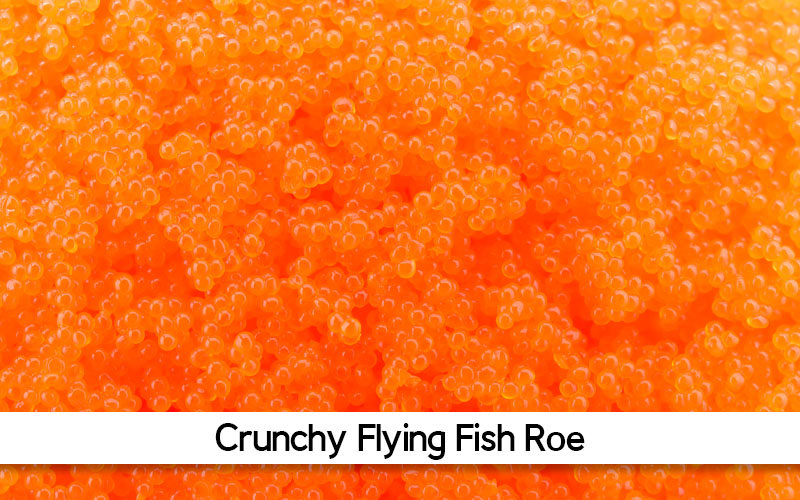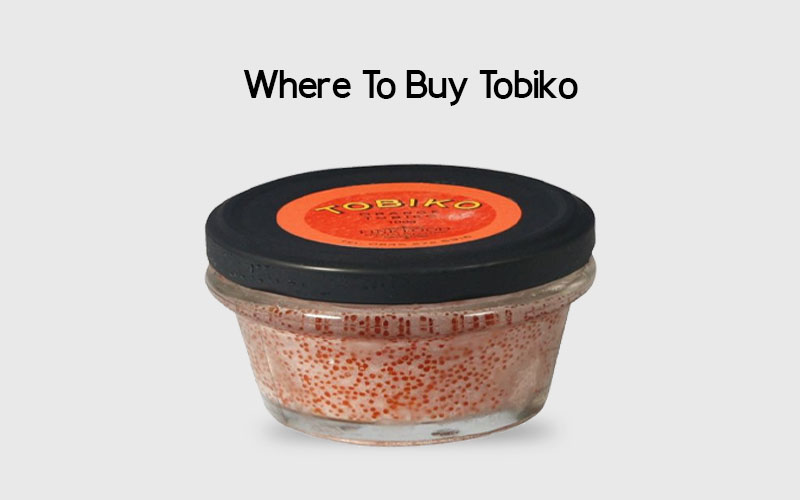Often, there are some words, that we don’t get an idea of like the name of a rare or unseen plant, a new dog breed, or some food cuisine.
When first heard about Tobiko, the thought came to mind that it maybe is some cartoon character’s name. LOL! But it isn’t.
So,
Table of Contents
What is Tobiko?

Tobiko is basically the Japanese word, used for roe flying fish. Roe or tobiko is used to create types of sushi.
The size of tobiko ranges from 0.5 mm to 0.8 mm.
Masago Vs Tobiko Vs Ikura.
You can say that tobiko is larger than capelin roe yet smaller than salmon roe.
Masago fish is small so it produces the smallest roe of all, while tobiko is larger than Masago yet smaller than Ikura.
As far as colors are concerned, Tobiko and Masago both have orange-red color.
However, Masago color is not as bright as that of tobiko. Besides this, ikura is roe from salmon fishes hence it has specific intense reddish-orange pigment.
The taste also differs: Ikura and tobiko have a crunch while masago is sandier in texture.
Identifying Tobiko:

To identify tobiko, first of all you can check for its size that’s mentioned above.
Apart from this:
You can take help from its color, texture, and of course, taste:
Tobiko Natural Color: Tobiko is found in red-orange color naturally.
Tobiko Texture: Tobiko has a crunchy texture.
Tobiko Taste: Tobiko is tasty egg or ovary having salty and mild smoky taste.
Apart from orange-red, tobiko is used in other colors as well based on the food preferences – that’s dyed tobiko.
Dyed Tobiko colors: Black, yellow, green, and pure-red colors are of dyed tobiko available in markets.
Tobiko Nutrients:

Seafood is always rich in proteins yet lower in calories. Here, though, in terms of nutrients, tobiko doesn’t disappoint you as it has a heavy amount of 40 % calories in it.
Rich in vitamin C, E, and B2 having quantity as 7%, 10 %, and 12 %, respectively. Along with this, you find 6 grams of proteins, 2 grams of fat, and less than 1 grams of carbs.
All with this, it contains 6 percent folate, 11 percent phosphorus, and 16% selenium.
Tobiko Benefits:

As you have seen, tobiko is loaded with necessary vita-nutrients and fatty acids.
However, you have also seen that it has 40 percent of calories.
Therefore, its regular use is not recommended due to high cholesterol content.
All with this, you don’t need to worry about calorie content when using Tobiko as a garnish.
Tobiko is used for?
Tobiko is flying fish roe (eggs), it is a delicate topping of Japanese cuisines. It is enjoyed as:
- Delicacy in Japanese cuisines
- Garnishing of sushi rolls
- In Sashimi
- As filling in crab cakes
- Various other seafood dishes
Is tobiko Safe to Eat?
Tobiko are small roe with high cholesterol content.
It is mostly consumed in very small quantity as topping, garnishing, and filling.
Hence, this moderation makes it safe to eat.
Most Popular Tobiko Recipe:
Now, you know everything about this amazing seafood topping, it is time to do some cooking and making a dish to enjoy boring quarantine.
Note: “Whenever cooking, ensure to make your kitchen fireproof, by installing a fire extinguisher or emergency fire blanket in there.”
1. Recipe for Tobiko Sushi Rolls:

- Ingredients you require:
Cooked Sushi rice, sesame seeds, tobiko flying fish roe (for topping)
For Filling:
Nori sheets
Cucumber strips
Cooked and chopped shrimps
Avocados
- Utensils you require:
One bamboo mat.
See Also: Best Tools And Equipment For Cooking
- Preparation:
- Place nori sheet’s half on the mat.
- Spread the sushi rice evenly like tortilla on it.
- Now spread all your favorite toppings over it.
- Roll the bamboo mat round and round with a little pressure (this is to make the rice tortilla tightly rolled like a roll)
- Remove mat
- Add tobiko on the top of the rolls
- Wrap the roll in a foil paper
- Slice the roll
- Remove the wrap
Tada! Your Tobiko Sushi rolls are ready.
Note: for best cooking experience, make sure you have all the tools and gears for cooking.
For more, check this video.
2. Tobiko Omelet Recipe – (preparation time 14 minutes):

It can be a perfect morning recipe that requires only 5 minutes if you prepare the ingredients at night and store them in Airtight bags to preserve their nutrients.
- Ingredients you require:
3 egg beats, Chinese Shaoxing wine for taste, 0.75 tsp oyster sauce, 0/5 tsp sesame oil, white paper 3 dashes, cooking oil 2 tsp, one sliced or chopped onion, tobiko roe 5 tbs, scallion green part cut in small pieces.
- Utensils you require:
A chopper set to chop veggies easily, one bowl to stir the ingredients together, heated stove, a plate to get the done omelet
- Preparations:
- Mix all the ingredients except the onions, sesame seeds, and tobiko roes, we will use them at the ending process of cooking.
- Heat the non-stick cooking mat and let it get hot a bit.
- Add onion and stir fry until they start getting crisper.
- Pour egg mixed mixture on the onions, spread it like a chapati bread.
- When cooked from one side, toss it, and cook the other side.
- When eggs are 80 percent done, add sesame seeds and Tobiko roes on it.
- Keep stirring for some more seconds and once you start getting aroma, toss the omelet in your plate.
You can use BBQ bags to cook your egg on a grill for barbequed taste
Enjoy!
3. Tobiko Salmon Mayo Rice

Third recipe for today that you can make using tobiko roe at hone is Salmon Mayo Rice edged with flying fish roe.
- Ingredients you require:
Nori, hot rice, mayonnaise, sriracha, tobiko, salmon, and salt to taste.
- Utensils you require:
Crusher, mixer bag, cooker.
- Process:
- Put nori in the bag, and press it so that it gets deeply crushed.
- Mix it with hot rice
- Add salt to taste or ¼ tsp
- Make sauce by mixing mayonnaise, sriracha, half tobiko, and salt. (Make sure to mix well).
- Put half nori in a plate and spread a layer of half-raw salmon.
- Sprinkle rest of the salmon and add taste for salt
- Cook, until you see salmon caramelized.
- While cooking spread the sauce you made.
- Once cooked, serve it with tobiko sprinkles.
Ta-Da! Mouthwatering yummy recipe is ready to eat.
Buying Tobiko:

Tobiko, as it is a famous roe used in Japanese cuisines mostly, you can easily buy tobiko at:
- Chinese markets
- Asian markets
- Famous online stores (for canned roe)
Tobiko Eating Guide:

Well, not all of us have tried every food and most of us go to different restaurants to try out new things.
So, when you go for tobiko brunching at a hotel, the chefs use Smelt roes (masago) instead of Tobiko, to cut the cost, as the former is cheaper.
For this, whenever you are dining out, try to order Wasabi tobiko, because that’s available in its original form.
Final Words:
This is all you need to know about Tobiko. Are we missing something? Let us know in the comment section below.
Also, do not forget to share your favorite tobiko recipe with us.
We will be coming with more fun blogs on food, till then;
Have a tasty day!

